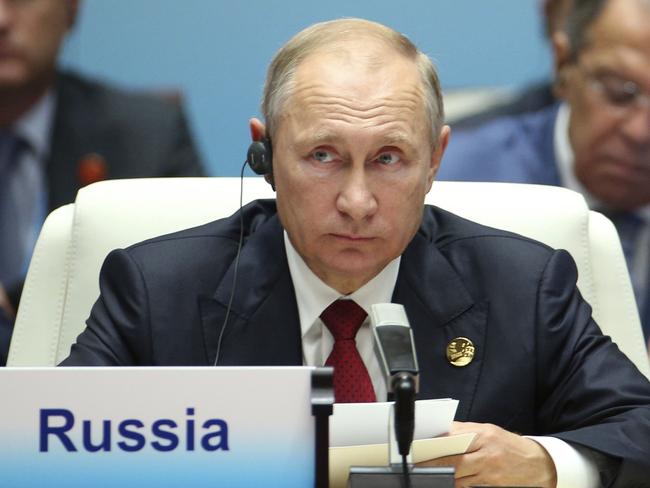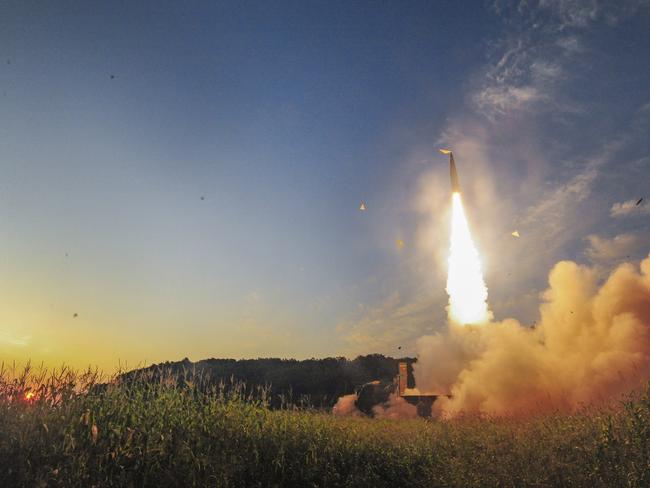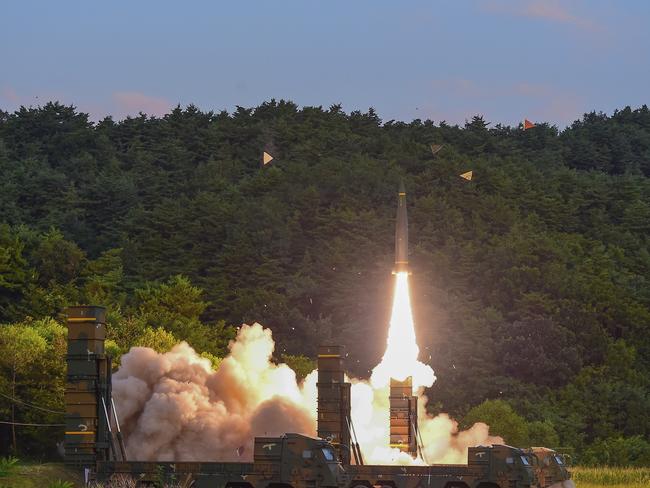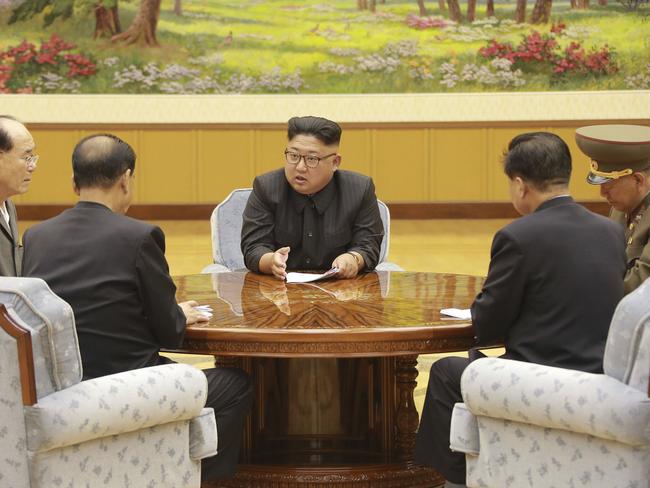‘People who mix up Australia and Austria’: Putin’s veiled attack on Trump over North Korea
RUSSIAN President Vladimir Putin says the US asking for his help with North Korea was a silly request, from those who “mix up Australia and Austria”.
VLADIMIR Putin has made a thinly veiled dig at Donald Trump, saying the US asking for Russia’s help to control North Korea was a silly request that could only be made by people who “mix up Australia with Austria.”
The Russian President said imposing tougher sanctions on North Korea over its nuclear missile program would be counter-productive and spoke out against “military hysteria” after the United States called for the “strongest possible measures” to rein in the rogue state.
“Russia condemns North Korea’s exercises, we consider that they are a provocation,” he said, but added: “Whipping up military hysteria makes absolutely no sense in this situation ... This is a road to nowhere.
“All of this can lead to a global planetary catastrophe and a great number of victims.”
Mr Putin refused to directly criticise Mr Trump, but said it was preposterous for Washington to ask for Moscow’s help after sanctioning Russian companies accused of violating North Korea sanctions. “It’s ridiculous to put us on the same (sanctions) list as North Korea and then ask for our help in imposing sanctions on North Korea,” said Mr Putin. “This is being done by people who mix up Australia with Austria.”
Mr Putin called for dialogue on the crisis and warned against measures that could escalate the situation. “Resorting to just any sanctions in this situation is useless and inefficient,” he said.
He said it was important that all parties including North Korea do not face “threats of annihilation” but “step on the path of cooperation.”

Mr Putin’s comments were made to reporters in the Chinese city of Xiamen after the annual BRICS (Brazil, Russia, India, China and South Africa) summit of five emerging economies. They came after North Korea detonated what it said was a hydrogen bomb on Sunday and announced it could mount the warhead on a missile, dramatically raising the stakes in Pyongyang’s standoff with the international community over its banned weapons programs.
‘RECKLESS AND DANGEROUS BEHAVIOUR’
German Chancellor Angela Merkel and the US President spoke about the provocation late on Monday and both “condemned North Korea’s continued reckless and dangerous behaviour”, reaffirming the importance of close coordination at the United Nations.
Ms Merkel called North Korea’s latest nuclear test a “flagrant violation” of international conventions, but said there can only be a “diplomatic and peaceful solution” of the crisis. She told the German parliament on Tuesday that North Korea’s distance from Germany should not keep the country from helping to end the crisis.
Japanese Foreign Minister Taro Kono told politicians it was time to increase pressure on North Korea and eliminate loopholes that allow some countries to continue trading with Pyongyang.
Malcolm Turnbull is due to speak to Mr Trump on Wednesday at 7.45am AEST and Defence Minister Marise Payne is heading to South Korea to help resolve the impasse.
The international community has become increasingly concerned after Sunday’s tests, with North Korea on Monday spotted moving what appeared to be an intercontinental ballistic missile towards its west coast, according to reports. An unidentified intelligence source revealed the move to South Korea’s Asia Business Daily a day after the North’s sixth and biggest nuclear test, as the South ramped up its military tests in response.

The rocket was spotted moving under cover of darkness to avoid surveillance, the report said. North Korea has launch facilities for its missile program on its west coast.
The destination could be Sohae Satellite Launching Station, a major intercontinental ballistic missile development and testing site around 200 kilometres northwest of Pyongyang, or a missile silo in mountainous Geumchang-ri, North Pyongan province.
But Brendan Thomas-Noone from the US Studies Centre said North Korea now has technology that allows it to launch missiles from road mobile launchers, on any flat surface. It could also fire a rocket over its own land, meaning the missile could head in any direction.

‘THEY’ll KEEP PUSHING UNTIL THEY CAN STRIKE THE US’
Mr Thomas-Noone told news.com.au Kim Jong-un could be purposely moving the rocket to demonstrate that the United States and South Korea will struggle to track and destroy its weapons. “It came from one of the missile factories on the west coast known to produce ICBMs,” he said.
“The last couple of tests have shown they can launch from multiple locations.
“They are obviously saying they’re working to keep pushing the envelope until they are confident they can strike the US with an ICBM.”
North Korea has already shown its ICBMs could threaten the US mainland by testing two in July that were capable of flying 10,000 kilometres.
“The last missile test fired directly up into the atmosphere — they can test missile distance without firing over land — this one started because they want to test the distance over land,” said Mr Thomas-Noone. “I expect them to do that.”
South Korea’s defence ministry said they were unable to confirm the report that North Korea is moving a rocket, but the ministry said in parliament on Monday that the North was considered ready to launch more missiles, including ICBMs, at any time.
It comes amid speculation the rogue nation may be planning to fire an ICBM as early as this weekend, when the republic celebrates its foundation on September 9.
North Korea has taken an ICBM out of its missile factory and is moving it west by night, South Korean daily reports https://t.co/hBJDfDMwr9 pic.twitter.com/t3vlwhgFAw
— Sam Kim 김혜성 (@samkimasia) September 5, 2017
‘THERMONUCLEAR WEAPON WITH SUPER EXPLOSIVE POWER’
South Korean warships conducted further live-fire exercises at sea on Tuesday as Seoul continued its displays of military capability after North Korea’s most powerful nuclear test to date.
South Korea’s presidential office said Washington had agreed to remove bilaterally agreed warhead restrictions on Seoul’s missiles, to allow it to develop bigger weapons that would boost its pre-emptive strike capabilities against the North.
The South’s military exercises on Monday involved F-15 fighter jets and land-based ballistic missiles simulating an attack on North Korea’s nuclear test site to “strongly warn” Pyongyang over the recent detonation.
The North’s underground test of what it claimed was a hydrogen bomb on Sunday had an estimated strength of 50 kilotons, according to the acting chief of South Korea’s defence ministry. North Korea released photos of Kim next to what it said was a bomb designed for an ICBM. Pyongyang called the device a “thermonuclear weapon with super explosive power” entirely made “by our own efforts and technology.”
South Korea’s military on Monday responded to North Korea’s nuclear test with live-fire exercises off its eastern coast involving ground and air-launched rockets. The South fired short-range Hyunmoo missiles into the sea to simulate an attack on the North’s main nuclear test site.

TURNBULL TO CALL TRUMP
The US has warned North Korea of a “massive military response” if there is any threat to America or its territories but launching an effective attack could be complicated.
There’s no question America has a huge weapons arsenal and nuclear bombs capable of annihilating vast swathes of the country. But mountainous North Korea spans 123,138 square kilometres and its latest machinations show it can move its deadliest weapons around in relative secrecy. If the US were to launch a pre-emptive strike, it would need to know where Kim’s nuclear sites are.
Mr Turnbull is due to speak with Donald Trump over the phone about the situation on Wednesday 7.45am AEST. The Prime Minister this morning agreed with US Ambassador to the UN Nikki Haley that North Korea was “begging for war”.
War would be “catastrophic” for the region, Mr Turnbull told Sydney radio station Nova FM 96.9. “It is extraordinary conduct but a war on the peninsula would result in thousands of deaths, extraordinary devastation,” he said. “It would be so damaging to the world, to the region, to the global economy.
“It would be a catastrophe.
“The need now is to enforce the toughest economic sanctions on North Korea.
“Now the Security Council has already imposed sanctions and what they are now considering is imposing even tougher ones.”
— With wires




